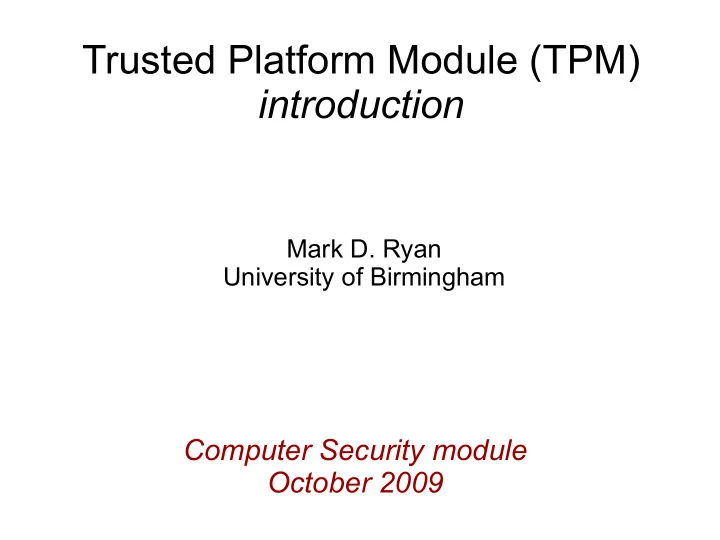

Trusted Platform Module (TPM) introduction Mark D. Ryan University of Birmingham Computer Security module October 2009
The Trusted Computing Group ● An industry consortium including – Microsoft, HP, Dell, Sony, Lenovo, Toshiba, Vodafone, Seagate, . . . – (about 160 organisations in total) ● Main output is Trusted Platform Module spec – The specification is publicly available – The TPM is a passive device (it does not monitor or prohibit anything; just performs actions if asked) – It is mandated to be opt-in , not opt-out – It includes privacy-enabling functionality
The Trusted Platform Module • A hardware chip currently included in 100M laptops – HP, Dell, Sony, Lenovo, Toshiba . . . – Soldered onto the motherboard, on the LPC bus – HP alone ships 1M TPM-enabled laptops each month • Specified by the Trusted Computing Group – An industry consortium that includes Intel, HP, Microsoft, AMD, IBM, Sun, Lenovo. . . . and 130 other members • Manufactured by many companies – Atmel, Broadcom, Infineon, Sinosun, STMicroelectronics, and Winbond • Supporting software to be rolled out over the next few years – MS BitLocker is the only mainstream application so far
TPM functionality Platform integrity Secure storage Platform reporting authentication – Creation of RSA keys (with – Creation of – “Measurement” and private part attestation identity reporting of integrity known only to keys (AIK) , with of platform; may the TPM) anonymity include – Encryption and guarantees (DAA) measurement of decryption of BIOS, disk MBR, user data with boot sector, those keys operating system and application software
TPM architecture Non-volatile memory Processor Endorsement Key Hash engine Storage Root Key RSA key generation Volatile memory RSA signing and encryption Platform configuration registers Random number generator Loaded keys
Secure storage Secure storage – Keys are created with TPM_CreateWrapKey ● Passwords (known as “authdata”) are specified for each key ● Keys are arranged in a tree hierarchy ● The TPM returns the created key as a blob; the secret parts are encrypted with the parent key – The function TPM_Seal encrypts data ● It also “seals” it to specified PCR values ● The command returns the sealed blob ● The sealed blob is protected by another piece of authdata, specified at the seal time
TPM command message flow (abstract view) User process TPM TPM_CreateWrapKey( keyinfo ) keyblob TPM_LoadKey2( keyblob ) handle TPM_Seal( handle, data ) sealedblob “Sealing” means encrypting and binding to PCRs
TPM authData • To each TPM object or resource is associated an authData value – A 160-bit shared secret between user process and TPM – Think of it as a password that has to be cited to use the object or resource • authData may be a weak (guessable) secret – May be based on a user-chosen password; e.g. in Microsoft Bitlocker. • The TPM resists online guessing attacks of weak authdata by locking out a user that repeatedly tries wrong guesses – Details are left to manufacturer
OIAP and OSAP User process TPM User process TPM keyAuth keyAuth keyAuth keyAuth TPM_OSAP( keyHandle, No' ) TPM_OIAP( ) authHandle, Ne, Ne' authHandle ● Long-lived session ● Session may be shortlived ● Allows different objects in ● Just one object same session ● Because K is cached, ● Authdata must be cited authdata need not be cited each command for each command
TPM_CreateWrapKey in more detail User process TPM parentKeyAuth parentKeyAuth TPM_OSAP( parentKeyHandle, NoOSAP ) authHandle, Ne, NeOSAP K = hmac( parentKeyAuth ; NeOSAP, NoOSAP ) ; TPM_CreateWrapKey( parentKeyHandle, encAuth, keyInfo, authHandle, No ) hmac( K ; encAuth, keyInfo, Ne, No ) Ne', keyBlob hmac(K; keyBlob, Ne', No)
TPM_LoadKey2 in more detail User process TPM parentKeyAuth parentKeyAuth TPM_OIAP( ) authHandle, Ne TPM_LoadKey2( parentKeyHandle, keyBlob, authHandle, No ) hmac( parentKeyAuth ; keyBlob, Ne, No ) Ne', handle hmac( parentKeyAuth ; Ne', No)
Platform measurement ● The TPM has 24 Platform Configuration Registers (PCRs) – Used to record platform configuration – x is a “measurement” of some part of the platform – TPM_Extend(p,x) “stores” the value x on the PCR p – TPM_Extend(p,x) means: p := SHA1( p || x) – p contains a proof of the record of the values that have been extended into it.
Core root of trust for measurement
Platform integrity reporting ● TPM_Quote returns a signature (using a TPM key) on the PCR p. ● A remote party can use that to be convinced of the integrity of the platform ● The key used is an attestation identity key (AIK), that has a certificate demonstrating that it is a real TPM key.
Attestation using a Privacy CA PCA User process TPM TPM_MakeIdentity( ) AIK EK AIK { Cert PCA (AIK) } K { K, AIK } EK TPM_ActivateIdentity( { K, AIK } EK ) K
TPM architecture Non-volatile memory Processor Endorsement Key Hash engine Storage Root Key RSA key generation Volatile memory RSA signing and encryption Platform configuration registers Random number generator Loaded keys
TPM: summary ● Commands – Authdata ● Storage ● Platform integrity measurement ● Platform integrity reporting – Attestation – Privacy preserving
MS BitLocker and TPM How to ensure only MSBL has access to volume decryption key? [Simplified story] ● On boot, control passes to pre-bios. ● Pre-bios measures bios, extends PCR, passes control. ● Bios measures other hardware and MBR, extends PCR, passes control. ● MBR measures MSBL, extends PCR, passes control. Begin window. ● MBSL retrieves vol id key and extends PCR with “stop value”. End window. ● MBSL starts decrypting disk and launches OS.
Recommend
More recommend